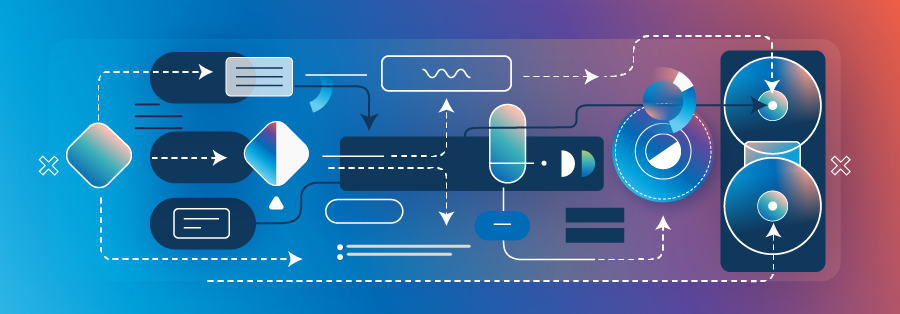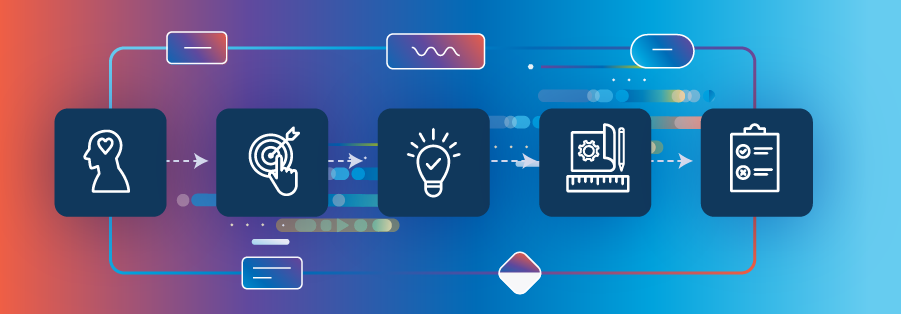Business Process Modeling

In general, organizations have an idea of how their business processes run. You might even know where the major bottlenecks and successes are. But having a general idea of these things is a far walk from knowing exactly what happens in each step of a process – details you can obtain via a business process analysis. Knowing these steps brings you closer to being able to challenge your current way of doing things, root out inefficiencies and bottlenecks, and discover new opportunities for business process optimization.
Business process modeling, in its most basic form, can be used to give your business analysts insights into the end-to-end lifecycle of your business processes using a visual flowchart. They can then use that flowchart to analyze how your organization currently runs and simulate how it could run better in the future.
Process modeling also paves the way for tools like business process management (BPM), which, as software can orchestrate processes using these data-driven visualizations of your workflows. BPM will help you document your processes, view key metrics and unearth potential problems that may inhibit you from implementing some form of business process automation.
As a methodology, BPM connects your workforce with your processes and technology throughout the BPM lifecycle of discovery, analysis, design, implementation and improvement.
What Is Business Process Modeling?
A business process model gives you a graphical representation of a workflow or business process, including all the subprocesses, roles and steps within it to help you analyze and optimize them.
There are different levels of business process modeling depending on how granular you need to go, but in general, process modeling shows all your business activities represented in a diagram or flowchart. You can also group similar processes to help anticipate how they should operate.
A process model can include:
- The devices, software and tools used in a process.
- Flow objects showing events, activities and gateways.
- The roles of those involved in the tasks.
- Any decision point or path diversion.
- Each path or workflow’s outcome.
- A timeline for each step in the process.
- Marks of successes and failures.
How Are Business Process Models Made?

While you could technically develop a business process manually using paper and gathering insights from business users familiar with the processes (called a process map), there’s always a chance you’ll miss something. It can be very time-consuming and tends to give a higher-level, broad view of workflows. A process model, on the other hand, takes a deep dive into workflows for more data-driven insights.
This is where tools like data mining algorithms come in handy. Process intelligence, which includes process mining and task mining, can help organizations capture their existing processes and equip them with further analyzing and optimizing of business processes.
After mining this data, you can input it into a BPM platform such as SS&C | Blue Prism® Chorus to build and automate processes, optimize workflows, create digital customer experiences and accelerate straight-through processing.
Business process modeling techniques
There are several standardized ways of rendering your process model:
- Business process modeling and notation (BPMN): A standardized process model and notation method developed by the object management group (OMG). It’s used for visualizing your business processes in an understandable way that can be communicated across the business and at any level.
- Unified modeling language (UML): A standardized modeling language that integrates diagrams and is designed to help system and software developers visualize, create and document artifacts.
- Universal process notation (UPN): Uses easy-to-read, universal notations by illustrating business processes in boxes, with each box representing a unique step in the process. It’s useful for designing, analyzing and understanding processes.
These notation systems are meant to standardize how you communicate complex processes using visual elements with universally recognized meanings. Regardless of which technique you choose, the standard methodologies tend to represent sequence flows (arrows), decision points and gateways (diamonds), beginnings and endpoints (ovals), specific workflow activities (rectangles) and process owners/roles (swim lanes).
What Do You Need in a Business Process Modeling Software?
Any business process modeling tools ought to represent business processes in a clear, easy-to-understand way. They should also be user-friendly, so stakeholders from top-level executives to business analysts and IT developers can read and extract insights from the models.
Effective modeling tools should have:
- Intuitive and accessible user interfaces for use across business departments.
- Simple, universal language to communicate across teams.
- Compliance guardrails to suit the industry.
- Integrated workflows and graphical interfaces.
- A workflow simulator to help plan improvements before implementation.
Benefits of Business Process Modeling

Knowledge is power. Process modeling gives organizations transparency and understanding of their business processes. These insights can help standardize processes, save time and remove redundancies. Let’s look at some of the benefits in detail.
Creating opportunities for automation
By modeling out your current processes and optimizing them, you’re setting up your business processes for tools like intelligent automation (IA), also called digital process automation. IA employs robotic process automation (RPA) and BPM along with artificial intelligence (AI) to automate end-to-end business processes and streamline workflows using a digital workforce.
Data-driven insights
By better understanding your as-is processes, you can equip your teams to drive more value and come up with better ways of working. Process modeling helps business users visualize a process, but it also makes it easier to integrate that understanding with BPM software. Of BPM’s many benefits, foremost among those is that it helps you orchestrate and manage work across your entire organization. That’s going to help optimize and standardize your processes, allowing you to automate and scale more easily.
Continuous business process improvement
Process modeling is an important step for organizations wanting to continually improve business processes. Optimization is an ongoing process of finding more opportunities to streamline work. By modeling your current processes, you can pinpoint areas where you’re underutilizing resources or where you might have redundancies. Once you’ve optimized your workflows, you can use process modeling to standardize the workflows across your entire enterprise.
Assessing new processes
Once you’ve set up standard procedures for your processes, it will be easier to implement and evaluate new ones. With a new process model, your business users can use BPM software for a real-time look at how the workflow is performing and make the necessary adjustments as it runs.
Communicating processes
Communication is key to an effective business unit, and process models can help clear up confusion and set a consistent tone for how your workflows run. Process models take complex processes and turn them into graphical interfaces you can interpret visually. This makes it easier to talk through processes and facilitates more efficient troubleshooting.
Lower operational costs
Process models help you easily identify optimization opportunities so you can ensure your processes run consistently and with the desired outcomes. This requires fewer maintenance costs by reducing bottlenecks and inefficiencies and takes less time to gather insights and make decisions.
Business Process Model Use Cases

Business process modeling is a versatile tool; you can apply it to any industry, department or workflow to help you find optimization opportunities and make better decisions. Let’s reflect on some common use cases you might apply in your organization:
Business requirements definition
When creating a business use case for a new system, product or service, a process model can help the relevant stakeholders better visualize the flow of information, tasks and resources that might be required to meet your business objectives.
Software development
In software development, you can use process modeling to create detailed specifications for your developers. It helps ensure that the software aligns with business requirements and functions as intended.
Change management
Big organizational changes like mergers, acquisitions or restructuring can quickly become disorganized. Modeling processes before and after these organizational changes can help stakeholders assess the change’s impact on workflows, resource allocation and performance.
Compliance and regulation
Modeling can help ensure your organization is compliant with industry regulations and standards. This is especially important for highly regulated industries, but you can apply it to any organization.
Risk management
By modeling your processes, you get an overview of everything, and that can help identify and mitigate risks. You can visualize any potential risks and assess their impact, then implement proactive controls to minimize their impact.
Training and documentation
Visual models of your captured processes can help you create training materials and documentation for employees. This helps standardize procedures, onboard new employees and ensure operational consistency.
Optimizing the customer experience
Model customer-facing processes such as sales, support and onboarding to see where potential pain points may be. This can help you streamline customer interactions and deliver more value to them, which can help your organization grow.
Insightful Optimization
Business process modeling can help your organization understand your current processes by seeing them visually. From there, you can find growth opportunities, reroute resources and remove redundancies. Empower your people for better work with streamlined and purposeful work.
We want to help you achieve more with your business processes. Read our BPM e-book to uncover how orchestrating your people, processes and digital workforce can help level up your efficiency and achieve enterprise-wide digital transformation.
